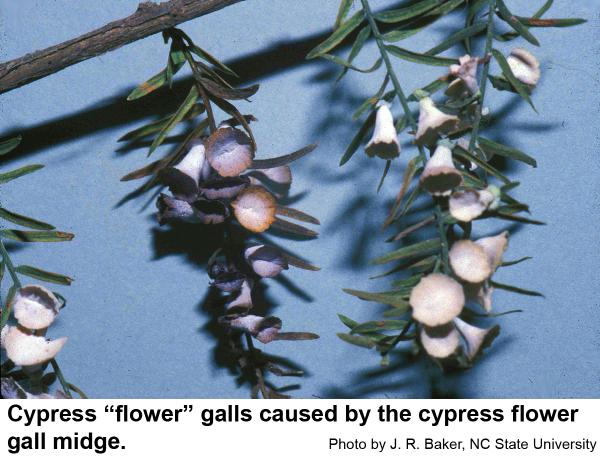Description and Biology
The cypress flower gall midge, Taxodiomyia cupressi, emerges in early sping. Females lay their eggs on newly developing cypress needles, and their maggots hatch and feed and cause the needle to form a small, white, flower-like gall inside of which the maggot develops. Their galls resemble tiny narcissus flowers with a broad corolla and a small ring of tissue at the base that somewhat resembles narcissus petals. The wide end of the corolla is concave, often with a linear depression across the middle. These galls are snow white but gradually darken to pink, tan, and then brown. The maggots mature and probably pupate inside the galls. It is likely that we have only one generation per year in North Carolina.
Host Plants
Bald cypress and pond cypress seem to be the only host plants of the cypress flower gall midge.
Residential Recommendations
By the time cypress flower galls are noticed, it is too late to control the midges. As these galls do no discernible damage to the health of cypress trees, we suggest it is better just to admire the flowers than to vainly apply an insecticide. Insect populations vary greatly from year to year and place to place, and because gall midges are plagued with parasites, it is likely an infested tree will have fewer "flowers" next year.
Other Resources
- Cypress Twig Gall Midge, Vol. 4, No. 29. Layton, B. Jr. 2018. Mississippe State University Extension.
- Extension Plant Pathology Publications and Factsheets
- Horticultural Science Publications
- North Carolina Agricultural Chemicals Manual
For assistance with a specific problem, contact your local N.C. Cooperative Extension center.
This Factsheet has not been peer reviewed.
Publication date: April 1, 2019
Reviewed/Revised: Jan. 11, 2024
N.C. Cooperative Extension prohibits discrimination and harassment regardless of age, color, disability, family and marital status, gender identity, national origin, political beliefs, race, religion, sex (including pregnancy), sexual orientation and veteran status.

